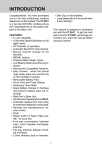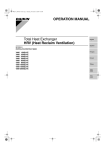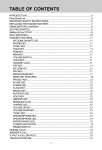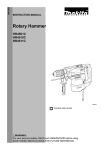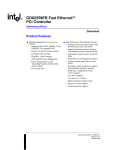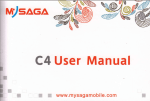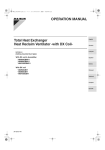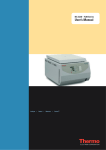Download Daikin RK25BVMB User`s manual
Transcript
3P130767-1_Cover.fm Page 1 Friday, December 12, 2003 11:30 AM MANUALE D’USO OPERATION MANUAL Scambiatore totale di calore HRV (Ventilazione per recupero del calore) -con bobina DXTotal Heat Exchanger HRV (Heat Reclaim Ventilation) -with DX CoilMODELLI (Tipo a condotto montato sul soffitto) MODELS (Ceiling mounted duct type) Con bobina DX & apparecchio umidificatore With DX coil & Humidifer VKMP50GMR VKMP80GMR VKMP100GMR Italiano English 3P130767-1_illust.fm Page 0 Friday, December 12, 2003 9:26 AM HRV HRV; Ventilazione per recupero del calore • Grazie di aver acquistato questo scambiatore di calore totale Daikin. Prima di usare lo scambiatore di calore totale, leggere con attenzione questo manuale d’istruzioni. Esso insegna il modo corretto di utilizzare l’unità e fornisce consigli, nel caso si verifichino dei problemi. Il manuale si riferisce solo all’unità interna. Usarlo insieme al manuale di istruzioni dell’unità esterna. Dopo aver letto il manuale, conservarlo per riferimenti futuri. • Questa unità è un tipo opzionale di condizionatore d’aria a sistema VRVII. Normalmente deve essere usato insieme al condizionatore d’aria per interni, sistema VRVII di tipo M. (RXYQ, REYQ, RXQ) È anche possibile utilizzare questa unità come sistema indipendente. • Per controllare l’unità, utilizzare il telecomando del condizionatore d’aria interno a sistema VRVII. HRV; Heat Reclaim Ventilation • Thank you for purchasing this Daikin total heat exchanger. Carefully read this operation manual before using the total heat exchanger. It will tell you how to use the unit properly and help you if any trouble occurs. This manual explains about the indoor unit only. Use it along with the operation manual for the outdoor unit. After reading the manual, file it away for future reference. • This unit is an option type for the VRVII system air conditioner. It should normally be used in combination with the M-type VRVII system indoor air conditioner. (RXYQ, REYQ, RXQ) It is also possible to use this unit as a independent system. • Use the remote controller of the VRVII-system indoor air conditioner to control the unit. 3P130767-1_illust.fm Page 1 Friday, December 12, 2003 9:26 AM MODELS VKMP50GMR VKMP80GMR VKMP100GMR (1) Hanger bracket (7) Maintenance cover (8) Heat exchanger elements (3) Exhaust fan It exchanges the heat (temperature and humidity) from indoors with the air taken in from outdoors, changes the outside air to the same condition as indoors and then brings it indoors. (2) Duct connecting flange (6) Electric parts box (12) Gas pipe (13) Liquid pipe (5) Damper (16) Strainer (included) (4) Air filter (Long life filter) (14) Drain outlet (10) Air supply fan (19) Remote controller (Optional accessory) (9) Name plate (15) Humidifier (Natural evaporating type) (11) Direct expansion coil Important Sometimes when first using the unit, the smell of the heat exchanging element may be noticeable, but it is not harmful. The smell will gradually go away as the unit is used. (11) Direct expansion coil (17) Feed water tank (20) Damper motor (21) EA Exhaust air to outdoors (22) OA Fresh air from outdoors (outdoor air) (23) RA Return air from room (24) SA Supply air to room (18) Solenoid valve (15) Humidifier (Natural evaporating type) 1 [1] 3P130767-1_illust.fm Page 2 Friday, December 12, 2003 9:26 AM • Combined operation system with VRV systems Indoor unit HRV-With DX Coil- Remote controller for indoor unit Outdoor unit • Independent system HRV-With DX Coil- Outdoor unit Remote controller for indoor unit Remote controller for VRV BRC1A61, 62 3 2 NOT AVAILABLE Remote controller for VRV BRC1C61 4 3 4 4 1 1 2 3 Remote controller for VRV BRC1C61 Remote controller for VRV BRC1A61, 62 5 [2] 5 3P130767-1_illust.fm Page 3 Friday, December 12, 2003 9:26 AM 1,2,3 1,2,3 Remote controller for VRV BRC1A61, 62 6 Remote controller for VRV BRC1C61 6 1 1 3 2 3 Remote controller for VRV BRC1A61,62 7 2 Remote controller for VRV BRC1C61 7 (1) Air filter 8-2 8-1 9 10 (1) Heat exchanger element (×2) (2) Handle (3) Rail 11 12 [3] 3P130767-1_En.fm Page 1 Wednesday, December 17, 2003 7:39 PM With DX coil & Humidifer VKMP50GMR VKMP80GMR VKMP100GMR Total Heat Exchanger HRV (Heat Reclaim Ventilation) -with DX Coil- CONTENTS 1. 2. 3. 4. 5. 1. ILLUSTRATIONS................................................... [1][2][3] SAFETY CAUTIONS ....................................................... 1 WHAT TO DO BEFORE OPERATION............................. 3 OPERATION PROCEDURE............................................ 6 MAINTENANCE (for a qualified service person only) ..... 8 TROUBLE SHOOTING.................................................... 9 Operation manual • Keep all flames away if the refrigerant leaks. The refrigerant in the air conditioner is safe and normally does not leak. If the refrigerant leaks inside the room, the contact with a fire of a burner, a heater or a cooker may result in a harmful gas. Extinguish all flames from burning appliances (such as stoves, heaters, etc.) ventilate the room, and contact your dealer. Do not use the air conditioner until when a service person confirms to finish repairing the portion where the refrigerant leaks. SAFETY CAUTIONS Read the following cautions carefully and use your equipment properly. This unit comes under the term “appliances not accessible to the genetic public.” There are two kinds of safety cautions and tips listed here as follows: WARNING............... Improper handling can lead to such serious consequences as death or severe injury. CAUTION................ Improper handling can lead to injury or damage. It could also have serious consequences under certain conditions. NOTE • These instructions will ensure proper use of the equipment. Be sure to follow these important safety cautions. Keep these warning sheets handy so that you can refer to them if needed. Also, if this equipment is transferred to a new user, make sure to hand over this user’s manual to the new user. WARNING (During Operation) • Never inspect or service the unit by yourself. Ask a qualified service person to perform this work. (The qualified service person) • In order to avoid electric shock, fire or injury, or if you detect any abnormality such as smell of fire, turn off power and call your dealer for instructions. • It is not good for your health to expose your body to the air flow for a long time. • Do not operate the unit with a wet hand. An electric shock may result. • Open the windows and ventilate the room if flammable gas is leaked. Insufficient ventilation when the unit is turned on or off may cause an explosion from sparks at the electrical connection. • Do not wash the HRV unit with water. Electric shock or fire may result. (Not including air filters, etc.) • Be sure to stop the unit and turn off the power when cleaning or inspecting it. As the fan is rotating at high speed, it will cause injury. CAUTION (During Operation) • Do not use the HRV unit for other purposes. In order to avoid any quality deterioration, do not use the unit for cooling precision instruments, food, plants, animals or works of art. • Do not use burning appliances directly in the path of the air from the unit. Incomplete combustion of the burning appliances may occur. • Never expose little children, plants or animals directly to the air flow. Adverse influence to little children, animals and plants may result. • Neither place a flammable spray bottle near the HRV unit or indoor intake and outlet grills nor perform spraying. Doing so may result in a fire. • Turn off the power when the unit is not to be used for long periods of time. Otherwise, the unit may get hot or catch on fire due to dust accumulation. • Do not block the intake or outlet grills. If the fan does not blow air throughout the entire room it may cause machine trouble. • Always use the air filter. If the air filter is not used, heat exchange elements will be clogged, possibly causing poor performance and subsequent failure. • Use gloves when cleaning. Cleaning without gloves may cause injury. • Do not use benzene or thinner to clean the outside surfaces of the air conditioner. This may cause cracks, discoloration, or machine trouble. • Do not operate the HRV unit in Bypass mode when the room air is under heating in winter or when the outside temperature is 30°C or higher. This may cause condensation to form on the main unit or on discharge grill, or around air supply opening. • Do not operate the remote controller with wet hands. This may cause electric shock. • Never touch the internal parts of the controller. Do not remove the front panel. Some parts inside are dangerous to touch, and a machine trouble may happen. For checking and adjusting the internal parts, contact your dealer. • Do not change operations suddenly. It can result not only in malfunction but also failure of switches or relays in the remote controller. 1 English 3P130767-1_En.fm Page 2 Wednesday, December 17, 2003 7:39 PM • Never press the button of the remote controller with a hard, pointed object. The remote controller may be damaged. • Do not let any kind of sprays get on the remote controller (insecticides, cleaning materials, etc.) This may cause breakage, deformation, or malfunction. • Do not wipe the controller operation panel with benzine, thinner, chemical dustcloth, etc. The panel may get discolored or the coating peeled off. If it is heavily dirty, soak a cloth in water-diluted neutral detergent, squeeze it well and wipe the panel clean. And wipe it with another dry cloth. • For refrigerant leakage, consult your dealer. When the HRV unit is to be installed in a small room, it is necessary to take proper measures so that the amount of any leaked refrigerant does not exceed the limiting concentration even when it leaks. If the refrigerant leaks exceeding the level of limiting concentration, an oxygen deficiency accident may happen. • Do not install the HRV unit at any place where flammable gas may leak out. If the gas leaks out and stays around the unit, a fire may break out. CAUTION (For installation) WARNING (For installation) • Do not attempt to install the unit yourself. Ask your dealer for installation of the unit. Incomplete installation performed by yourself may result in a water leakage, electric shock, and fire. • Installation should be done following the installation manual. Incorrect installation may cause leaking, electric shock, or fire. Injuries may result if the unit falls. • Do not install the unit in locations where the temperature in the areas around the unit or indoor intake and outlet grills may fall below freezing. The water pipes, humidifier element, solenoid valves, and other components may freeze, causing breakage and leaks. • Do not allow exhaust air to enter the outside air intake vent. This may cause the interior of the room to become contaminated and harming the health. • Locate the outside air intake vent so that it does not take in exhaust air which contains combustion air, etc. Incorrect installation may cause a loss of oxygen in the room, leading to serious accidents. • All wiring must be performed by an authorized electrician. To do wiring, ask your dealer. Never do it yourself. • Make sure that a separate power supply circuit is provided for this unit and that all electrical work is carried out by qualified personnel according to local lows and regulations. Insufficient power circuit capacity or incorrect work may cause electric shock or fires. • Be sure the unit is electrically earthed. In order to avoid electric shock, make sure that the unit is grounded and that the earth wire is not connected to gas or water pipe, lightning conductor or telephone earth wire. Install a wiring interrupter or ground-fault circuit interrupter for the power wiring. • Install the unit on a foundation strong enough to withstand the weight of the unit. A foundation of in sufficient strongth may result in the unit falling and causing injuries. • Connect the remote controller to the correct model. This may cause electric shock or fire. • Do not move or attempt to re-install the remote controller yourself. Incorrect installation, may cause electric shock or fire. Contact your dealer to have such work done. English • Do not use the HRV unit or an air suction/discharge grille in the following places. 1. Place subjected to high temperature or direct flame. Avoid a place where the temperature near the HRV unit and the air suction/discharge air grille exceeds 40°C. If the unit is used at high temperature, deformed air filter and heat exchange element or burned motor result. 2. Place such as bathroom subjected to moisture. Electric leak or electric shock and other failure can be caused. 3. Place such as kitchens or other places where oil fumes are present. This may cause fire. 4. Place subjected to much carbon black. Carbon black attaches to air filter and heat exchange element, marking them unable to use. 5. Place such as machinery plant and chemical plant where gas, which contains noxius gas or corrosive components of materials such as acid, alkali, organic solvent and paint, is generated. Place where combustible gas leakage is likely. This may cause gas poisoning or fires. • Is a show protection measure taken? For detail, consult your dealer. • In order to avoid electric shock or fire, make sure that an earth leakage breaker is installed. No installation may cause electrical shock and fire. • Make sure the temperature and the humidity of the installation location is within the usage range, not exceed the limit. Do not install in cold storage or other locations with low temperatures or near heated pools. This may cause fires or short circuits. • Install the two outdoor ducts with down slope to prevent rainwater from entering the unit. If this is not done completely, water may enter the building, damaging furniture, and cause electric shock and fire. • Insulate the two outdoor ducts to prevent dew condensation (and the indoor duct as well if needed). If this is not done completely, water may enter the building, damaging furniture, etc. • Use electric insulation between the duct and the wall when using metal ducts to pass metal or wire laths or metal plating into wooden buildings. This may cause electric shock, short circuits, or fire. • Arrange the drain hose to ensure smooth drainage. Incomplete drainage may cause wetting of the building, furniture etc. • Do not install the remote controller in locations where the temperature exceeds the range between 0°C and 35°C and the humidity exceeds the range between RH 40% and 80%. Electrocution or breakdown may occur. 2 3P130767-1_En.fm Page 3 Wednesday, December 17, 2003 7:39 PM • Do not place the controller exposed to direct sunlight. The LCD display may get discolored, failing to display the data. • Avoid placing the controller in a spot splashed with water. Water coming inside the controller may cause an electric leak or may damage the internal electronic parts. • Never pull or twist the electric wire of a remote controller. It may cause the unit to malfunction. (For moving and reinstalling/ WARNING repairing) • Do not modify the unit. This may cause electric shock or fire. • Ask your dealer to move and reinstall the unit. Incomplete installation may result in a water leakage, electric shock, and fire. • Do not disassemble or repair the unit yourself. This may cause electric shock or fire. Contact your dealer to have such work done. • When removing the unit, be sure not to tip it. The water inside the unit may drip or leak out, and get on furniture, etc. 2. WHAT TO DO BEFORE OPERATION This operation manual is for the following systems with standard control. Before initiating operation, contact your Daikin dealer for the operation that corresponds to your system type and mark. If your installation has a customized control system, ask your dealer for the operation that corresponds to your system. 2-1 NAMES OF PARTS (Refer to figure 1) (1) (2) (3) (4) (5) (6) (7) (8) (9) (10) (11) (12) (13) (14) (15) (16) (17) (18) (19) (20) (21) (22) (23) (24) Hanger bracket Duct connecting flange Exhaust fan Air filter (Long life filter) Damper Electric parts box Maintenance cover Heat exchanger elements Name plate Air supply fan Direct expansion coil Gas pipe Liquid pipe Drain outlet Humidifier (Natural evaporating type) Strainer (included) Feed water tank Solenoid valve Remote controller (Optional accessory) Damper motor EA Exhaust air to outdoors OA Fresh air from outdoors RA Return air from room SA Supply air to room 2-2 REMOTE CONTROLLER AND CHANGEOVER SWITCH: NAME AND FUNCTION OF EACH SWITCH AND DISPLAY (Refer to figure 3 and 4) • Only the items marked with an asterisk (∗ mark) are explanation relating to the functions and display of the unit. Unmarked items are functions of the combined air conditioners. When using buttons for functions which are not available (buttons which are not described in the text) will cause “NOT AVAILABLE” to be displayed. Contact your dealer for more detailed descriptions of those functions (buttons). ∗1 On/off button Press the button and the system will start. Press the button again and the system will stop. ∗2 Operation lamp (red) The lamp lights up during operation. ∗3 Display “ ” (changeover under control) May be displayed when combined with a VRV-system air conditioner. It is impossible to changeover heat/cool with the remote controller when this icon is displayed. ” (air flow flap) 4 Display “ This displays the direction and mode of the air flow flap of the combined air conditioner. 5 Display “ ” (ventilation/air cleaning) This display shows that the total heat exchange and the air cleaning unit are in operation. (these are optional accessories) 6 Display “ C ” (set temperature) This displays the set temperature of the combined air conditioner. It is not displayed when the unit is used as an independent system. ”“ ”“ ”“ ”“ ” (operation 7 Display “ mode) This displays the operating status of the combined air conditioner. • There is no “heating” for the VRVII system (Cooling only type). • “ ” is only available for systems operating in cooling and heating at the same time. ” (programmed time) ∗8 Display “ This display shows the programmed time of the system start or stop. 9 Display “ TEST ” (inspection/test operation) When the inspection/test operation button is pressed, the display shows the mode in which the system actually is. • Do not use under usual use (service person/installer only). 10 Display “ ” (under centralized control) When this display shows, the system is under centralized control. (This is not a standard specification.) ” (fan speed) ∗11 Display “ This display shows the fan speed you have selected. ∗ This is only displayed when the fan speed selection button is pressed. It normally displays the set fan strength of the combined air conditioner. ” (time to clean air filter) ∗12 Display “ Refer to “4-1 HOW TO CLEAN THE AIR FILTER”. 13 Display “ ” (defrost/hot start) It may be displayed when the combined air conditioner is in heating mode. 3 English 3P130767-1_En.fm Page 4 Wednesday, December 17, 2003 7:39 PM ∗14 Timer mode start/stop button Refer to the chapter “Operation procedure Programming start and stop of the system with timer.” (Refer to page 7 (3-3)) 2-3 Explanation for SYSTEMS ∗15 Timer on/off button Refer to the chapter “Operation procedure Programming start and stop of the system with timer.” (Refer to page 7 (3-3)) ∗16 Inspection/test operation button Pressed during inspection or “test run.” • Do not use under usual use. (service person/installer only) ∗17 Programming time button Use this button for programming start and/or stop time. ! OPERATION for EACH SYSTEM 18 Temperature setting button Use this button for setting the desired temperature of air conditioner combined with this unit. ∗19 Filter sign reset button Refer to “4-1 HOW TO CLEAN THE AIR FILTER”. 20 Fan speed control button Press this button to select the fan speed of air conditioner combined with this unit. ∗21 Operation mode selector button Press this button to select the operation mode of air conditioner combined with this unit. 22 Air flow direction adjust button Press this button to select the air flow direction of air conditioner combined with this unit. 23 Fan only/air conditioning selector switch Set the switch to “ ” for fan only operation or to “ for heating or cooling operation. 24 Cool/heat changeover switch Set the switch to “ ” for cooling or to “ operation. This unit can be made a part of two different systems: as part of the combined operation system used together with VRVII SYSTEM Air Conditioners and as the independent system using only the HRV. An operating remote controller is required when using the unit as an independent system. Ask your dealer what kind of system your system is set up for before operation. For the operation of the remote controller for indoor unit and centralized controller, refer to the instruction manual provided with each unit. See the included operating manuals for details on how to operate each remote control. Sample system (Refer to figure 2) Combined operation system with VRVII systems [Operation] The air conditioner remote controller stars and stops the air conditioner and the HRV unit. You can also select the ventilation amount and the ventilation mode. During intermediate periods when only the HRV unit is used without the air conditioner, select “ventilation” with the operation selection button.(Refer to 2-4.) Sample system (Refer to figure 2) Independent system [Operation] The HRV unit can be started and stopped using the remote controller. You can also select the ventilation amount and the ventilation mode. 2-4 ABOUT DIRECT DUCT CONNECTION SYSTEM Installation Examples Direct duct connection system ” ” for heating 25 Remote controller thermo This detects the temperature around the remote controller. This is not the same as the temperature of return air from room (RA) by heat exchanger unit. (HC0007) Independent duct system ∗26 Display “ ”“ ”“ ” This displays the ventilation mode. (BRC1C61 and so on.) (This is not displayed on the controller BRC1A61, 1A62) ∗27 Display “NOT AVAILABLE” • “NOT AVAILABLE” may be displayed for a few seconds if the function for the button pressed is not available for the unit or the air conditioner. • “NOT AVAILABLE” is only displayed when none of the indoor units is equipped with the function in question when running several units simultaneously. It is not displayed if the function is available on even one of the units. ∗28 Ventilation fan mode selector button (available only connecting the HRV unit) This is pressed to switch the fan mode of the HRV unit. ∗29 Ventilation fan speed control button (available only connecting the HRV unit) This is pressed to control the fan speed of the HRV unit. (Refer to item 11) NOTE • In contradistinction to actual operating situations, the display on figure 3 shows all possible indications. • If the filter sign lamp lights up, clean the air filter as explained in the chapter “MAINTENANCE”. After cleaning and reinstalling the air filter: press the filter sign reset button on the remote controller. The filter sign lamp on the display will go out. English (HC0008) The HRV unit cannot be operated independently when the air conditioner is connected to the HRV unit via a duct. When using the HRV unit, set the air conditioner to “fan” mode on weak fan strength. Operation mode display “Ventilation” is displayed. Operation mode selector button hr hr TEST NOT AVAILABLE TEST Remote controller for indoor unit 4 3P130767-1_En.fm Page 5 Wednesday, December 17, 2003 7:39 PM • Each time you press the operation selection button, the operation mode display will change as shown in the figure below. Example 1: In case of the remote controller “BRC1C61” and as equivalent. Display changes as below. When air conditioner and HRV unit are not connected via duct <Operation mode> VRV: Cooling mode HRV: Heat exchange mode VRV: Fan mode HRV: Heat exchange mode VRV: Stopping HRV: Heat exchange mode Example 2: In case of the remote controller “BRC1A61,62” Display changes as below. When air conditioner and HRV unit are not connected via duct <Operation mode> VRV: Cooling mode HRV: Heat exchange mode VRV: Fan mode HRV: Heat exchange mode VRV: Stopping HRV: Heat exchange mode When air conditioner and HRV unit are connected via duct When air conditioner and HRV unit are connected via duct <Operation mode> VRV: Cooling mode HRV: Heat exchange mode VRV: Fan mode HRV: Heat exchange mode <Operation mode> VRV: Cooling mode HRV: Heat exchange mode VRV: Fan mode HRV: Heat exchange mode NOTE) Current Ventilation mode doesn’t be displayed. NOTE) Current Ventilation mode can be visible and selected on the remote controller. 5 • When the display shows “ ” (time to clean air filter), ask a qualified service person to clean the filters (Refer to the chapter “MAINTENANCE”). English 3P130767-1_En.fm Page 6 Wednesday, December 17, 2003 7:39 PM 3. ! EXPLANATION OF OPERATION MODE OPERATION PROCEDURE 3-1 COOLING, HEATING, AND FAN ONLY OPERATION (Refer to figure 5) Cooling mode Heating mode [PREPARATIONS] • To protect the unit, turn on the main power switch 6 hours before operation. Do not turn off the power during the heating or cooling season. This is to ensure smooth start-up. Press the operation mode selector button several times and select the operation mode of your choice; 1 “ ” Cooling operation “ ” Heating operation “ ” Fan only operation Automatic mode It automatically selects “ ” or “ While operating in ventilation mode, the unit adjusts the outside air to the indoor temperature and then brings it into the room. .” Fan mode It only operates in ventilation mode. The unit processes outside air using the heat exchanger element, but not the DX expantion coil. NOTE NOTE • “ ” can only be set for systems operating in cooling and heating at the same time. • This unit cannot control room temperature. If this is needed, do not install the HRV unit alone, but rather install another indoor unit. “ ” is displayed on all remote controllers when using the VRVΙΙ system cooling only type, but only “ ” and “ ” can be set. • Select the operating mode on a remote controller on which “ ” is not displayed. “ ”“ ” and “ ” (only for simultaneous cooling/heating systems) cannot be selected on remote controllers on which it is displayed. See 3-2 if “ 2 Press ventilation fan mode button if you wish to change the fan mode. The display rotates through the following selections every time the button is pressed. Automatic mode 3 ” is displayed. Heat exchange mode Bypass mode Press ventilation fan speed button if you wish to change the fan speed. The display rotates through the following selections every time the button is pressed. L H After the selection, the ventilation fan speed display disappears. And the fan speed of the combined air conditioner requlary displays. 4 Automatic mode : When combined with a VRVΙΙ-system air conditioner The unit automatically switches between “ ” and “ ” based on information from the VRVΙΙ system air conditioner (heating, cooling, fan, and set temperature) and information from the HRV unit (indoor and outdoor temperatures). The unit automatically switches between “ ” and “ ” when it is combined with an air conditioner (Not producted by Daikin) and based on only the information from the HRV unit (indoor and outdoor temperatures) when the HRV unit is operating alone. Total heat exchange mode : Outdoor air passes through the heat exchange element and heat exchanged air is sent into the room. Bypass mode : In this mode outdoor air does not through the heat exchange element, but rather sent into the room as is. ! EXPLANATION OF HEATING OPERATION High Low ! EXPLANATION OF VENTILATION MODE Press the on/off button. The operation lamp lights up and the system starts operation. Stopping the system Press start/stop one more time. The operation lamp will go off. The unit will stop. Defrost operation • In heating operation, freezing of the outdoor unit coil increases. Heating capabitity decreases and the system goes into defrost operation. • The remote controller will read “ ” until the hot air starts blowing. • It returns to the heating operation again after 6 to 8 minutes (10 at the longest). Hot start • The remote controller will read “ ” until the hot air starts blowing, e.g. at the start of heating operation. • After stopping operation, the fan may continue operating for up to a minute. • The fan may stop, but this is not a malfunction. NOTE • Do not turn off the power immediately after operation stops. Wait at least 5 minutes. Not waiting may cause leaking or malfunction. English 6 3P130767-1_En.fm Page 7 Wednesday, December 17, 2003 7:39 PM 3-2 SETTING THE MASTER REMOTE CONTROLLER (Refer to Fig. 6) • When the system is installed as shown bellow it is necessary to designate one of the remote controllers as the master remote controller. • Only the master remote controller can select cooling, heating, or automatic operation (the last only on simultaneous cooling/heating systems). • The displays of slave remote controllers show “ ” (changeover under control) and they automatically follow the operation mode directed by the master remote controller. • “ • The ventilation mode can be changed regardless of the setting (main or slave). NOTE • This unit cannot control room temperature. If the unit is connected to the same system with other indoor units, set the master remote controller on the other indoor units. 2 However, it is possible to changeover to program dry with slave remote controllers if the system is in cooling operation set by the master remote controller. (Cooling/heating selection operation systems) ” flashes when the power is first turned on. 3 When multiple indoor units or this unit are connected to a single outdoor unit. Press the operation mode selector button of the controller that you wish to designate as the master remote controller. Then designation is completed. This remote controller is designated as the master remote controller and the display showing “ ” (changeover under control) vanishes. The displays of other remote controller show “ ” (changeover under control) Press the operation mode selector button on the master remote controller (i.e. a remote controller which does not display “ ”) to scroll through the modes.The display will scroll through “ ” – “ ” (only for simultaneous cooling/heating systems) – “ ” – “ ”. The display on slave remote controllers will also change automatically. ! Details and activity of operation HRV-with DX coil- Indoor unit One of these remote controllers can be designated as the master remote controller. 1. Setting the master remote controller (without the “ ” display) to cooling/heating mode will make slave remote controllers (with the “ ” display) to follow to the mode of the master remote controller. • Selection of fan mode is possible, however. 2. Setting the master remote controller (without the “ ” display) to fan mode will make slave remote controllers (with the “ than fan mode impossible (Simultaneous cooling/heating systems) If multiple indoor units or many of this unit are connected to outdoor unit via BS unit. BS unit: This is the unit which selects cooling and BS unit heating. HRV -with DX coil- HOW TO DESIGNATE THE MASTER REMOTE CONTROLLER 1 3-3 PROGRAMMING START AND STOP OF THE SYSTEM WITH TIMER (Refer to figure 7) • The timer is operated in the following two ways. Programming the stop time “ ”. The system stops operating after the set time has elapsed. Programming the start time “ ”. The system starts operating after the set time has elapsed. • The start and the stop time can be simultaneously programmed. Indoor unit One of these remote controllers can be designated as the master remote controller. Press the operation mode selector button of the current master remote controller for 4 seconds. The display showing“ ” (changeover under controll) of all slave remote controllers connected to the same outdoor unit or BS unit flashes on. ” display) any setting other 1 Press the timer mode start/stop button “ times and select the mode on the display. • For setting the timer stop “ ” several ” • For setting the timer start “ ” Each time the button is pushed, the indication changes as shown below. “No indication” “ ” “ ” OPTION C NOT 7 H English 3P130767-1_En.fm Page 8 Wednesday, December 17, 2003 7:39 PM Press the programming time button and set the time for stopping or starting the system. 2 Each time this button is pressed, the time advances or goes backward by 1 hour. • The timer can be programmed for a maximum of 72 hours. • Each time when “ ” is pushed, the time advances one hour. Each time when “ ” is pushed, the time goes back one hour. Press the timer on/off button. 3 The timer setting procedure ends. The display “ ” or “ ” changes from flashing light to constant light. • After the timer is programmed, the display shows the remaining time. For cancelling the timer operation, push the timer on/off button “ ” once again. The indication disappears. NOTE • When setting the timer off and on at the same time, repeat the above procedure (from “ 1 ” to “ 3 ”) once again. 4. MAINTENANCE (for a qualified service person only) ONLY A QUALIFIED SERVICE PERSON IS ALLOWED TO PERFORM MAINTENANCE WARNING • BEFORE OBTAINING ACCESS TO TERMINAL DEVICES, ALL POWER SUPPLY CIRCUITS MUST BE INTERRUPTED. • To clean the HRV, or maintenance be sure to stop operation, and turn the power switch off. It may cause electrical shock and it is very dangerous to touch the rotating part. • Do not wash the HRV with water. Doing so may result in an electric shock. CAUTION • Use gloves when cleaning. Cleaning without gloves may cause injury. • Watch your step. Use caution, as this requires working in high places. ! DETAIL EXPLANATION 4-1 HOW TO CLEAN THE AIR FILTER When you want to stop operation after a desired time, Example: Set the time to “8”. ↓ Clean the air filter when the display shows “ CLEAN AIR FILTER). “ 8hr ” will display. Stops operation 8 hours after the reservation is complete. The program will be cleared after the operation stops. • Set the stop time during operation. When you want to start operation after a desired time has elapsed Example: Set the time to “8”. ↓ “ 8hr ” will display. Starts operation 8 hours after the reservation is complete. The reservation is cancelled after operation starts. • Set the start time while the unit is stopped. • The remaining time will count at the same time after reservation is complete. See the example below if you want to reserve “off after time” and “on after time” at the same time. For example: (Refer to figure below) When the timer is programmed to stop the system after 3 hours and start the system after 4 hours, the system will stop after 3 hours and start 1 hour later. Example: hr hr • Setting “off after 3 hours” and “on after 4 hours” will ↓ ” (TIME TO It will display that it will operate for a set amount of time. AT LEAST ONCE EVERY YEARS (FOR GENERAL OFFICE USE) (CLEAN THE MORE FREQUENTLY IF NECESSARY.) • Increase the frequency of cleaning if the unit is installed in a room where the air is etermely contaminated. • If the dirt becomes impossible to clean, change the air filter (Air filter for exchange is optional). 1. Detach the maintenance cover. Go into ceiling through the inspection hatch, remove binding metal of maintenance cover and take it off. (Refer to figure 8-1) 2. Detach the air filter. Take out from the heat exchange elements. (Refer to figure 8-2) 3. Clean the air filter. (Refer to figure 9) Use vacuum cleaner A) or wash the air filter with water B). A) Using a vacuum cleaner B) Washing with water When the air filter is very dirty, use soft brush and neautral detergent. After cleaning, remove water and dry in the shade. NOTE • Do not wash the air filter with hot water of more than 50°C, as doing so may result in discoloration and/or deformation. • Do not expose the air filter to fire, as doing so may result in burning. • Do not use gasoline, thinner, or other organic solvents. This may cause discoloration or deformation. 4. Fix the air filter. If the air filter is washed, remove water completely and allow to dry for 20 to 30 minutes in the shade. When dried completely, install the air filter back in place. (Refer to figure 10) • Operation will stop after 3 hours. Operation will then start in 1 hour from the time it stopped. English 8 3P130767-1_En.fm Page 9 Wednesday, December 17, 2003 7:39 PM NOTE • Be sure to install the air filter after servicing. (Missing air filter causes clogged heat exchange element.) The air filter is an optional item and the replacement is available. 5. Install the maintenance cover. Refer to page 8 (4-1, 1). For remote controllers which display the filter sign, turn on the power after maintenance, and press the filter sign reset button. ∗ Consult your dealer if you want to change the time setting for when the filter sign goes on. 4-3 INSPECTION AND MAINTENANCE OF THE HUMIDIFIER Have your dealer do the following inspections in order to get the longest use. Once a year is recommended. For dealers Content of maintenance Problems if Inspected maintenance Items to be part is not carried Solution inspected out Strainer (80-mesh) NOTE • Do not remove the air filter except when cleaning. Breakdown may occur. 4-2 HOW TO CLEAN THE HEAT EXCHANGE ELEMENT CAUTION • Do not clean touching strongly with a vacuum cleaner. This may crush the mesh of the heat exchange elements. • Never wash the heat exchange element with water. • Have your dealer professionally clean the filter if it is very dirty. 5. Put the heat exchange element on the rail and insert it securely in place. 6. Install the air filter securely in place. (Refer to page 8 (4-1, 4)) 7. Install the maintenance cover securely in place. (Refer to page 9 (4-1, 5)) Insufficient humidifying. Check o-ring for cracks Replace if cracked. Leaking. Check for operation of float switch Clean if it does not work properly due to buildup. Insufficient humidifying. Overflowed feed water tank. Clean if very dirty. Weak fan strength. Reduced humidifying capacity. Replace if it doesn’t work. Insufficient humidifying. Overflowed feed water tank. Check for dirt WARNING 1. Detach the maintenance cover. Refer to page 8 (4-1, 1). 2. Detach the air filter. Refer to page 8 (4-1, 2). 3. Take out the heat exchange elements. Pull out the air filter and then pull out the two heat exchanger elements. (Refer to figure 11) 4. Use a vacuum cleaner to remove dust and foreign objects on the surface of the heat exchange element. (Refer to figure 12) • Use the vacuum cleaner equipped with a brush on the tip of the suction nozzle. • Lightly contact the brush on the surface of the heat exchange element when cleaning. (Do not crush the heat exchange element while cleaning.) Clean if clogged. Feed water tank AT LEAST ONCE EVERY TWO YEARS (FOR GENERAL OFFICE USE) (CLEAN THE ELEMENT MORE FREQUENTLY IF NECESSARY.) • Please exchange the heat exchange element if you find that the knob of the heat exchange element is damaged or is deteriorated when cleaning it. There is falling danger. Check for clogging Solenoid valve Check for shutting and opening. Check in a similar fashion when checking the float switch operation. 4-4 REPLACING THE HUMIDIFIER ELEMENT • The humidifier element needs to be replaced regularly. The humidifier element should in general be replaced once every three years when supply water is soft water, but outside factors (water quality, hard water, etc.) as well as operating conditions (24-hour-a-day air conditioning, etc.) may shorten its productive life. • Contact your dealer if you have any questions. 5. TROUBLE SHOOTING 5-1 If one of the following malfunctions occurs, take the measures shown below and contact your Daikin dealer. The system must be repaired by a qualified service person. WARNING When the HRV is in abnormal conditions (smell of something burning, etc), cut off the power, and contact your dealer. Continued operation under such circumstances may result in a failure, electric shock, and fire. • If a safety device such as a fuse, a breaker, or an earth leakage breaker frequency actuates, or ON/OFF switch does not properly work. Measure: Do not turn the power on. • The remote control buttons do not work well. Measure: Turn off the main power switch. 9 English 3P130767-1_En.fm Page 10 Wednesday, December 17, 2003 7:39 PM • If the display “ ” (INSPECTION), ”UNIT No.” and the OPERATION lamp flash and the “MALFUNCTION CODE” appears. OPERATION lamp UNIT No. In case of the malfunction with the code in white letters on the black background in the unit still operates. However, be sure to have it inspected and repaired and as soon as possible. If any of the above error codes are displayed, there is a possibility that the problem in question has occurred with a combined air conditioner or outdoor unit. See the operation manuals included with the air conditioners or outdoor units for details. H INSPECTION display INDOOR UNIT No. in which a malfunction occurs MALFUNCTION CODE Measure: Notify and inform the model name and what the malfunction code indicates to your Daikin dealer. • There are other malfunctions. Measure: Stop the unit. List of malfunction codes of Remote controller of the HRV-system Operation lamp Inspec tion indicator Unit No. Malfunction code On Off Blinking 64 Indoor air thermistor malfunction On Off Blinking 65 Outdoor air thermistor malfunction On Off Blinking 6A Blinking Blinking Blinking 6A Blinking Blinking Blinking A1 On Off Blinking A1 Blinking Blinking Blinking A9 Electric expansion valve drive error Blinking Blinking Blinking C4 Liquid piping thermistor error (faulty connection, disconnection short circuit, fault) Blinking Blinking Blinking C5 Gas piping thermistor error (faulty connection, cut wire, short circuit, fault) Blinking Blinking Blinking C9 Intake air into coil thermistor error (faulty connection, disconnection, short circuit, fault) Blinking Blinking Blinking U3 Blinking Blinking Blinking U5 Off Blinking Off U5 Off Blinking Off U8 Transmission error between main remote controller and sub remote controller Off Blinking Blinking UA Incorrect combination with indoor unit and remote controller. On Blinking On UC Central control address over lapping Blinking Blinking Blinking UE Transmission error between the unit and centralized controller English Description Dumper-related malfunction Dumper-related malfunction + thermistor malfunction Printed circuit board fault Printed circuit board fault Test run not performed Transmission error between the unit and remote controller Setting error of remote controller 5-2 If the system does not properly operate except for the above mentioned case, and none of the above mentioned malfunctions is evident, investigate the system according to the following procedures. 1. The unit does not operate at all. • Check if there is a power failure. After power has been restored, start operation again. • Check if the fuse has blown or breaker has worked. Change the fuse or set the breaker. 2. Amount of discharged air is small and the discharging sound is high. • Check if the air filter and heat exchange element are clogged. Clean tha air filter and heat exchange element. 3. Amount of discharged air is large and so is the sound. • Check if the air filter and heat exchange element are not installed. Install the air filter and heat exchange element. 4. It dries usually in winter. • Is the water supply service valve open? Open the water supply service valve. • Have you lowered setting on the humidistat (locally procured) too far? Correct the setting. 5-3 The following malfunctions must be cheched by a qualified service person 1. Do not operate • Are there any problems with the power or wiring? Inspect the power and wiring. • Are there any problems with the fan unit? Inspect the fan motor and fan. 2. Humidifies very little or not at all. • Is there water in the water supply tank? 1 Is water being supplied? Inspect the water supply pipes and supply the water. 2 Is the strainer clogged? Clean the strainer. 3 Is the solenoid valve broken (i.e. won’t open)? Replace the solenoid valve. 4 Is the humidifier element torn? Replace. 5 Has the water resistance of the humidifier element dropped? Replace the humidifier element. 6 Are the control circuits broken? Replace the printed circuit board and other electric parts. • Is the float switch broken? Replace the float switch. • Is the water supply pressure sufficient? Re-set it so that there is sufficient pressure. • Is there foreign matter in the feed water tank? Clean the feed water tank. 10 3P130767-1_Cover.fm Page 2 Friday, December 12, 2003 11:30 AM 3P130767-1 EM03A089 (0311) FS HT
















